Diploblastic Study guides, Class notes & Summaries
Looking for the best study guides, study notes and summaries about Diploblastic? On this page you'll find 33 study documents about Diploblastic.
Page 3 out of 33 results
Sort by

-
BROOKS BIODIVERSITY UNIT 3 EXAM | QUESTIONS & ANSWERS (VERIFIED) | LATEST UPDATE | GRADED A+
- Exam (elaborations) • 47 pages • 2024
-
- $15.99
- + learn more
1 BROOKS BIODIVERSITY UNIT 3 EXAM | QUESTIONS & ANSWERS (VERIFIED) | LATEST UPDATE | GRADED A+ Plants Architecture Correct Answer: Plant needs i. collection & conversion of solar energy -> leaves ii. positioning & support of leaves -> stems iii. anchorage & absorption -> roots iv. transport -> vascular system Leaf Structure Correct Answer: Epidermis, Mesophyll, and Vein (Vascular Bundle) Epidermis contains what? Correct Answer: - Cuticle - Guard cells with Stomata ...

-
Test Bank For Animal Diversity 8th Edition By Hickman
- Exam (elaborations) • 363 pages • 2023
-
- $31.65
- + learn more
Animal Diversity, 8e (Hickman) Chapter 3 Animal Architecture 1) Which statement most closely represents the diversity of animal patterns resulting from the Cambrian time period? A) The Cambrian saw the first animal ancestor; all animal architecture dates back to these fossils. B) About 34 phyla evolved by the end of the Cambrian and there are now perhaps 100 phyla that have radiated from them. C) About 100 phyla evolved by the end of the Cambrian and there are now about 34 surviving animal p...

-
BIO 207
- Class notes • 69 pages • 2022
-
- $14.99
- + learn more
NATIONAL OPEN UNIVERSITY OF NIGERIA COURSE CODE : BIO 207 COURSE TITLE: LOWER INVERTEBRATES Course Code & Course Title: BIO 207: Lower Invertebrates Course Writer: Dr. Patrick A. Audu Course Editor Programme Leader Dr. Ado Baba Ahmed National Open University of Nigeria, Lagos Course Coordinator Mr. Adams, Abiodun E National Open Univers...
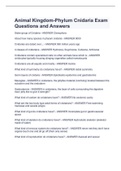
-
Animal Kingdom-Phylum Cnidaria Exam Questions and Answers
- Exam (elaborations) • 5 pages • 2022
-
- $9.99
- + learn more
Sister group of Cnidaria - ANSWER Ctenophora About how many species in phylum cnidaria - ANSWER 9000 Cnidarias are dated over... - ANSWER 580 million years ago 4 classes of cnidarians - ANSWER Hydrozoa, Scyphozoa, Cubozoa, Anthozoa Cnidarians contain specialized cells no other animals have which is - ANSWER cnidocytes-typically housing stinging organelles called namatocysts Cnidarians are all aquatic and mostly - ANSWER marine What kind of symmetry do cnidarians have? - ANSWER ...
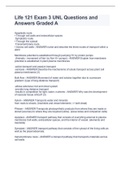
-
Life 121 Exam 3 UNL Questions and Answers Graded A
- Exam (elaborations) • 6 pages • 2022
-
- $9.99
- + learn more
Apoplastic route ▪ Through cell walls and extracellular spaces Symplastic route ▪ Through the cytosol Transmembrane route ▪ Across cell walls - ANSWER name and describe the three routes of transport within a plant Membrane potential is established through pumping H+ by proton pumps (Animals - movement of Na+ by Na+ K+ pumps) - ANSWER Explain how membrane potential is established in plant plasma membranes -active transport and passive transport -osmosis - ANSWER Describe the...
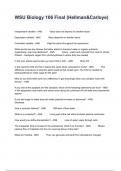
-
WSU Biology 106 Final (Hellman&Carloye) Questions With Correct Solutions
- Exam (elaborations) • 24 pages • 2024
-
- $12.89
- + learn more
WSU Biology 106 Final (Hellman&Carloye) Independent variable - ANS Value does not depend on another factor Dependent variable - ANS Value depends on another factor Controlled variable - ANS Kept the same throughout the experiment What are the two key tissues that allow plants to transport water or organic nutrients, respectively, over long distances? - ANS Xylem - water and minerals from roots to shoots Phloem - transports sugars from ...
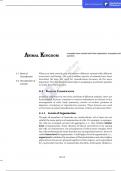
-
ANIMAL KINGDOM | MCAT Notes | UCAT notes | COMPLETE CLASS NOTES , Tricks & PYQ All Concp
- Class notes • 17 pages • 2023
-
Available in package deal
-
- $2.99
- + learn more
Basis of Classification , Classification of Animal , Levels of Organisation , Diploblastic and Triploblastic Organisation , Coelom , CLASSIFICATION OF ANIMALS , All phylum covers here with example , long question .
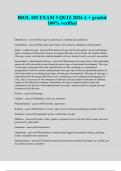
-
BIOL 181 EXAM 3 QUIZ 2024 A + graded 100% verified
- Exam (elaborations) • 4 pages • 2024
-
- $10.49
- + learn more
BIOL 181 EXAM 3 QUIZ 2024 A + graded 100% verified Diploblastic - answerhaving two germ layers; ectoderm and endoderm Triploblastic - answerhas three germ layers: the ectoderm, endoderm, and mesoderm. spiral vs radial cleavage - answerIn spiral cleavage, the division planes are not at 90 degree angles, resulting in blastomeres that are not aligned directly over or beside one another. Radial Cleavage: occurs such that the resulting daughter cells are located exactly on top of one another. ...
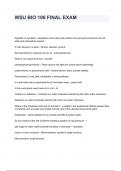
-
WSU BIO 106 FINAL EXAM Questions And Answers
- Exam (elaborations) • 8 pages • 2024
-
- $11.39
- + learn more
WSU BIO 106 FINAL EXAM Apoplast vs symplast - Apoplastic route water and solutes move along the continuum of cell walls and extracellular spaces 3 main tissues of a plant - dermal, vascular, ground Root developed in response to low o2 - pneumatophores What is not a plant hormone - secretin phototropin/phytochrome - These receive red light and control plant morphology sclerenchyma vs parenchyma cells - Sclerenchyma: dead, provide stability Parenchyma: Living cells, p...
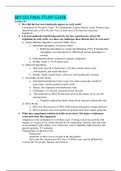
-
BIO 181 FINAL STUDY GUIDE, Latest complete guide (fall 2019/2020)
- Other • 82 pages • 2021
-
- $12.49
- + learn more
BIO 181 FINAL STUDY GUIDE Lecture #1: 1. How did the four macromolecules appear on early earth? Components of “Primitive Soup” Carbohydrates, Lipids, Nucleic Acids, Proteins (four macromolecules of life) We don’t have a clear answer but there are numerous hypotheses. 2. List and explain the basis/ background for the four main theories of how life originated on early earth. Are there any challenges these theories have to overcome? a) Oparin-Haldane Hypothesis (tested by Miller-Urey) a. ...

How much did you already spend on Stuvia? Imagine there are plenty more of you out there paying for study notes, but this time YOU are the seller. Ka-ching! Discover all about earning on Stuvia


